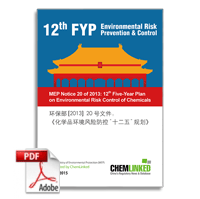
English version available!
12th Five-Year Plan on Environmental Risk Control of Chemicals
On 2 Feb 2013, China MEP circulated the “12th Five-Year Plan for the Environmental Risk Control on Chemicals”. The plan acknowledged the environmental risk brought by chemicals and formulated future initiatives of environmental risk control over chemicals and industries.
58 categories of chemicals with high environmental concerns have been established for Particular Prevention and Control, which include:
25 categories of chemicals with cumulative risks, which will compose as a major part of the to-be-released “Hazardous Chemicals of Priority Environmental Concern” (HCPEC list). Measures such as source prevention, exposure reduction, registration management and submission of “release & transfer report of the HCPECs” will be implemented over companies of hazardous chemicals, with the goal to achieve the efficient risk control.
15 categories of chemicals with a high occurrence rate for environmental accidents in the recent years are to be stringently controlled by improving warning and emergency management system;
30 categories of characteristic pollutants (including 12 categories of chemicals with high environmental accidents occurrence rate), of which emission will be deduced. Relevant standards will be further polished and industries/companies involved should expect more demanding requirements for the environmental impact assessment, and receive more stringent monitoring of these pollutants from the authority.
Table 1 58 Categories of Chemicals under Particular Prevention and Control
Chemicals with cumulative risks | Chemicals with a high occurrence rate for environmental accidents | Characteristic Pollutants | |
p-phenylenediamine trichloroacetic acid; cyclohexane; dicyclohexylamine; 1,2-dichloroethane; allylaldehyde; acrylamide; ethylene oxide; trichloroethylene; bisphenol A nonyl phenol diethyl phthalate(DEP); 1,2,3-trichlorobenzene; 2,4,6-tri-tert-butylphenol; p-chloroaniline; malononitrile; p -amino-phenol; 3,4-dichlorobenzene; 2,3,4-Trichloro-1-butene; hexachloro-1,3-butadiene; anthracene; octachlorostyrene; diphenylmethanone; p-nitrotoluene; Chlorotributyltin | petroleum(diesel oil, crude oil, gasoline, fuel oil); Acids(hydrochloric acid, sulfuric acid; nitric acid, chlorosulfonic acid); Benzenes( benzene, toluene, dimethylbenzene); organic amines (aniline, anilinomethane, nitroaniline, tribromoaniline); ammonia(liquid ammonia); cyanides; chlorine; phosphorus; methanol; phenol; tetrachlorosilane; esters(butyl acrylate, ethyl acetate, methyl methacrylate); styrene; cyclohexanone; hydrogen sulfide;
| Aquatic Pollutants | Air Pollutants |
petroleum*; volatile phenols; cyanides*; fluorides; sulfide; benzene*; toluene*; ethylbenzene; anilines; formaldehyde; nitrobenzene; acids*; dibutyl phthalate(DBP); dioctyl phthalate(DEHP); acrylonitrile; chlorobenzenes; chemical pesticides; phenols*;
| formaldehyde; benzene*; toluene*; dimethylbenzene*; phenols; benzopyrene; fluorides; chlorine*; hydrogen sulfide* anilines*; chlorobenzenes; chloroethylene;
| ||
Note: the “*”marked chemicals/categories in the Aquatic Pollutants and “Air Pollutants” are also included in the chemicals with a high occurence rate for environmental accidents | |||
The chemicals with high toxicity, non-degradability and high environmental risk were blueprinted to be eliminated or restricted in the future. The MEP will review the environmental risk of the PBTs, vPvBs and the CMRs and update the elimination list and the substitutes list of harmful chemicals. Initiatives for control and obsoleting the vPvB will be launched during the Five-Year Plan.














